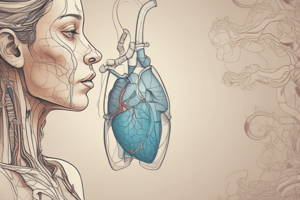Podcast
Questions and Answers
What is the primary purpose of the respiratory system?
What is the primary purpose of the respiratory system?
- To humidify and cleanse air before inhalation
- To supply oxygen to the blood and remove carbon dioxide (correct)
- To regulate blood pressure and blood flow
- To enhance communication and vocalization
Which of the following structures is NOT considered a principal organ of the respiratory system?
Which of the following structures is NOT considered a principal organ of the respiratory system?
- Lungs
- Esophagus (correct)
- Pharynx
- Trachea
Which section of the respiratory system is responsible for the exchange of gases?
Which section of the respiratory system is responsible for the exchange of gases?
- Conducting division
- Respiratory division (correct)
- Upper respiratory tract
- Dead-end pathway
What role does the nose play in the respiratory process?
What role does the nose play in the respiratory process?
During inspiration, where does the incoming air stop for gas exchange?
During inspiration, where does the incoming air stop for gas exchange?
What is the primary function of the nasal cavity?
What is the primary function of the nasal cavity?
Which part of the respiratory system is referred to as the upper respiratory tract?
Which part of the respiratory system is referred to as the upper respiratory tract?
What type of tissue primarily supports the shape of the nose?
What type of tissue primarily supports the shape of the nose?
What is a common misconception about the conducting division of the respiratory system?
What is a common misconception about the conducting division of the respiratory system?
What forms the wall that divides the nasal cavity into left and right halves?
What forms the wall that divides the nasal cavity into left and right halves?
What are the main functions of the larynx?
What are the main functions of the larynx?
Which of the following statements describes the bronchi's structure?
Which of the following statements describes the bronchi's structure?
What is the role of the epiglottis during swallowing?
What is the role of the epiglottis during swallowing?
Where is the hilum located in relation to the lungs?
Where is the hilum located in relation to the lungs?
What structure is primarily responsible for sound production?
What structure is primarily responsible for sound production?
What does pleura refer to in relation to the lungs?
What does pleura refer to in relation to the lungs?
How does the structure of the trachea support its function?
How does the structure of the trachea support its function?
What distinguishes the right lung from the left lung?
What distinguishes the right lung from the left lung?
Which of the following regions do NOT belong to the pharynx?
Which of the following regions do NOT belong to the pharynx?
What best describes the function of the nasal conchae?
What best describes the function of the nasal conchae?
Flashcards
Respiration
Respiration
The process of taking in oxygen and releasing carbon dioxide.
ATP
ATP
Chemical energy used by cells for various functions.
Alveoli
Alveoli
The structure where gas exchange occurs in the lungs.
Conducting Division
Conducting Division
Signup and view all the flashcards
Respiratory Division
Respiratory Division
Signup and view all the flashcards
Upper Respiratory Tract
Upper Respiratory Tract
Signup and view all the flashcards
Lower Respiratory Tract
Lower Respiratory Tract
Signup and view all the flashcards
Inspiration
Inspiration
Signup and view all the flashcards
Expiration
Expiration
Signup and view all the flashcards
Nostrils (Nares)
Nostrils (Nares)
Signup and view all the flashcards
Nasal Conchae
Nasal Conchae
Signup and view all the flashcards
Meatus
Meatus
Signup and view all the flashcards
Pharynx (Throat)
Pharynx (Throat)
Signup and view all the flashcards
Epiglottis
Epiglottis
Signup and view all the flashcards
Larynx
Larynx
Signup and view all the flashcards
Glottis
Glottis
Signup and view all the flashcards
Trachea
Trachea
Signup and view all the flashcards
Bronchi
Bronchi
Signup and view all the flashcards
Lungs
Lungs
Signup and view all the flashcards
Pleura
Pleura
Signup and view all the flashcards
Study Notes
Respiratory System Overview
- Breathing is vital for life, representing the most dramatic moments of human experience.
- Respiration, a process of exchanging gases, is crucial for ATP production and waste elimination.
- Respiration is a critical component of metabolism.
Main Function
- The respiratory system's primary function is providing oxygen to the blood and removing carbon dioxide.
- The system involves tubes delivering air to the lungs for gas exchange.
Diverse Respiratory Functions
- Gas exchange (oxygen in, carbon dioxide out).
- Communication, through the voice box and other parts.
- Smell recognition (olfaction).
- Sound production (in the larynx).
- Acid-base balance regulation.
- Blood pressure regulation.
- Expelling abdominal contents.
- Kidney function (via respiratory system).
- Vital for circulatory system.
Conducting Zone (Upper Respiratory Tract)
- Nostrils (nasal cavity).
- Pharynx (throat).
- Larynx (voice box, sound production).
Respiratory Division (Lower Respiratory Tract)
- Trachea (windpipe).
- Bronchi, bronchioles, and alveoli.
- Alveoli (tiny air sacs) are the gas exchange sites in the lungs.
Lungs
- Three faces: diaphragmatic, costal, and mediastinal.
- The root of the lungs (hilum): the passageway for vessels, nerves, and bronchi.
Pleura
- A double-layered membrane surrounding the lungs.
- Visceral pleura (inner layer): directly on the lungs.
- Parietal pleura (outer layer): lines the chest cavity.
- A space, called the pleural space, separates the two layers and is filled with fluid to prevent friction.
Studying That Suits You
Use AI to generate personalized quizzes and flashcards to suit your learning preferences.




